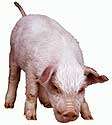CDC preparing vaccine for new swine flu

(HealthDay) -- Only 29 human cases of a new strain of "swine" flu have been identified in two years, but the U.S. Centers for Disease Control and Prevention is making sure it's prepared should the H3N2 strain become more widespread.
"This virus is still principally a swine virus, but it doesn't seem to have onward spread. It's still not a human virus," Dr. Joseph Bresee, from the CDC's influenza division, stressed during a noon press conference Friday.
"Even so, a H3N2 candidate vaccine has been prepared and clinical trials are being planned for this year," he said.
The reason the CDC is concerned about this particular virus is that it contains an element seen in the pandemic 2009 swine flu strain, H1N1, which may make it more likely for the virus to spread from person-to-person.
All 29 cases were infected with strains of H3N2 "that contained the matrix (m) gene from the influenza A H1N1 pandemic virus," Bresee explained. "This 'm' gene may confer increased transmissibility to and among humans, compared with other variant influenzas viruses."
In addition, the virus appears to have become more active recently, the CDC said. "The virus was first detected in humans in July 2011, and since then there have been 29 total cases of H3N2 variant virus detected, including the 16 cases occurring in the last three weeks," Bresee said.
Of the 12 cases reported this week, 10 were from Ohio and one each came from Hawaii and Indiana, the CDC said.
According to Bresee, "29 cases of infection with this H3N2 virus since 2011 is a significant increase for these types of viruses that we have seen in recent years."
Flu viruses commonly circulate in pigs, Bresee noted. But they are generally different from those that spread to people. Sometimes these viruses can spread to people, however, which happens most often when someone comes into close contact with an infected animal, he explained.
"Swine influenza viruses have not been shown to be transmissible to people through eating, or handling pork or other products derived from pigs. It is not a food-borne disease," Bresee said.
Each of the recent 16 cases were among people who had direct contact with pigs. In 15 cases, contact happened at a county fair, he added.
It may yet be possible, however, to transmit this virus from one infected person to another, Bresee said.
No human-to-human transfer of the virus occurred in the more recent cases, Bresee said, although scientists did find evidence of limited human-to-human transmission in three cases in 2011.
Fortunately, sustained person-to-person transmission of the virus hasn't happened yet, he added.
Of the 16 new cases, 13 arose in children, according to the CDC. Studies indicate that children may be more susceptible to the infection than adults, as occurred during the 2009-2010 pandemic H1N1 flu outbreak, Bresee said.
Right now, there is no cause for alarm, the CDC said. Symptoms of this flu are similar to seasonal flu, none of the recent 16 cases required hospitalization and there were no deaths. This flu did hospitalize three people with underlying disease last year, he noted.
"We expect more cases from contact with pigs and through limited human-to-human spread," Bresee said. "We also suspect that some of the cases might be severe."
Reported cases usually represent a small number of actual cases, since most people don't see a doctor and many doctors don't report flu cases.
Bressee said, however, it's too early to hazard a guess about how many cases of this flu there might actually be.
"Because influenza viruses are always evolving, we will watch closely for signs that the virus has gained capacity for efficient and sustained human-to human transmission," Bresee said.
"Thus far, we have not seen this type of transmission and therefore are not seeing features consistent with an influenza pandemic."
To prevent contracting this flu, the CDC advises people to limit their contact with swine and avoid contact with sick swine. People who have contact with these animals should take precautions such as washing their hands, not eating or drinking in areas with swine and controlling their cough.
More information: For more on H3N2 flu, visit the U.S. Centers for Disease Control and Prevention.
Copyright © 2012 HealthDay. All rights reserved.

















